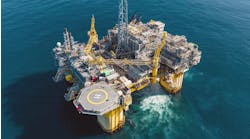Nick Terdre
Contributing Editor
FMC Kongsberg Subsea is to supply the world’s first full-scale subsea separation system, for use on the Tordis Field in the Norwegian North Sea. In October, operator Statoil sought approval from Norway’s government for a two-stage development project, with an estimated cost of NKr 1.8 billion.
It aims to improve oil recovery from Tordis from the previous target of 49% to 55%, equivalent to an additional 35 MMbbl of oil. Subsea separation technology will account for 19 MMbbl of this total.
Tordis came onstream in 1994 through subsea facilities tied back to the Gullfaks C platform. Assuming approval for the new scheme, production will now be boosted through increased water in water injection. This in turn will require new facilities to handle large volumes of produced water.
Under the project’s first phase, Statoil plans a conventional approach - increasing water handling capacity on Gullfaks C - with subsea separation introduced in the second stage.
Subsea separation was piloted by Norsk Hydro on the Troll Field, also in the North Sea, but Tordis will have the first full-scale system, capable of handling 200,000 b/d of liquids and injecting 150,000 b/d of water back beneath the seabed. Sand will also be removed and disposed of.
Statoil signed the contract for a subsea separation station with FMC in November. The facility is due to come onstream in October 2007.
“Tordis is a similar system to Troll Pilot but will have much higher capacity and much more functionality,” says Martin Sørensen, manager, Technology & Business Development in FMC. “Our overall design strategy has been to keep it simple, robust and reliable.”
The subsea separation, boosting and injection (SSBI) station will weigh about 900 metric tons, with a footprint of 30 m x 25 m. The separation process will be three-phase, with the gas separated out by a cyclone separator at the inlet. In the separator vessel - almost 20 m long and 2.3 m in diameter - separation of liquids will take place by a gravity process, with the oil settling on top of the water.
Separated oil will be collected by a standpipe at the far end of the separator vessel, and the gas recombined with it. A multiphase pump will assist oil/gas flow on its way to Gullfaks C. The separated water will exit the separator vessel via a pipe located at the far end from the inlet. It will be routed to the water injection pump, heading from there through a flexible jumper to the injection well, which will be completed with a large-bore, simplified christmas tree.
The liquid interface in the separator will be maintained at the correct level by adjusting the offtake of water. Liquid level monitors will keep constant track of the water and oil levels. Additional monitoring of the production as well as the SSBI station will be provided by two multiphase meters at each in-flow line at the station and a flow meter at the produced water outlet.
Three level monitors will keep track of sand build-up at the bottom of the tank. Sand production could reach 500 kg a day, necessitating a removal operation typically every couple of days.
Sand will be flushed out of the separator vessel using pressurized water taken off the injection water line, with the sand-water mixture routed into a de-sander module. The latter will comprise a 6-m high and 1.5-m diameter vertical vessel, with the sand settling at the bottom via gravity. It will then be jetted out and combined into the produced water flow downstream of the water injection pump, ending up in the water disposal well.
Both pumps will require a 2.3-MW power supply, to be provided directly as AC power via an electro-hydraulic umbilical. Control of the process facilities will be managed via a separate umbilical, to be supplied by ScanRope Subsea Cable. This will be connected to a subsea control module with 51 functions.
The design of the separation system and supply of the separation vessel internals is the responsibility of CDS Engineering, a Dutch company specializing in separation technology that was acquired by FKS in 2003. The vessel itself will be manufactured by the German company Hans Leffer. Fabrication of the foundation structure and manifold will be carried out by Grenland Offshore in Norway, a regular partner of FMC.
The station will be installed as a single unit, but to facilitate intervention, all critical parts, including the separator module, de-sander module, and pumps, will be retrievable independently.
“We are experiencing a rapidly increasing interest in subsea processing, both locally and globally,” says Sørensen.
“We recently entered into a long-term cooperation agreement with Siemens Power Generation to jointly develop subsea gas compression technology, for which Siemens brings to the table a novel and very exciting seal-less compression technology, just as we want it for subsea use.”
The two companies will tender for Norsk Hydro’s Ormen Lange subsea gas compression pilot station and are also involved in Statoil’s subsea gas compression project for Åsgard.




